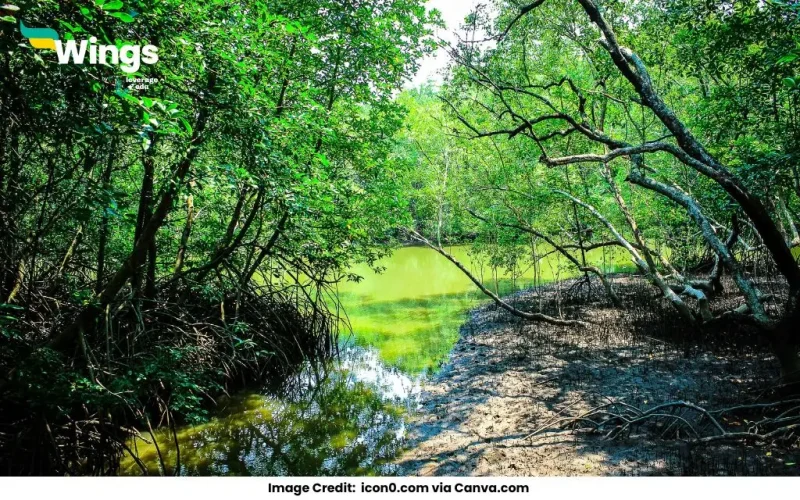Answer: The major areas where mangrove forests are found in India include:
Sundarbans (West Bengal) – The largest mangrove forest in India and home to the Royal Bengal Tiger.
Mahanadi Delta (Odisha) – Found in Bhitarkanika National Park, rich in biodiversity.
Godavari-Krishna Delta (Andhra Pradesh) – Supports a diverse range of species.
Pichavaram Mangroves (Tamil Nadu) – Known for its scenic beauty and unique ecosystem.
Kaveri Delta (Tamil Nadu) – Located along the southeastern coast.
Andaman and Nicobar Islands – Densely covered with mangrove vegetation.
Gulf of Kutch (Gujarat) – Features arid coastal mangroves.
Complete Answer:
Mangrove forests are a vital part of India’s coastal ecosystem, providing habitats for diverse species and acting as natural barriers against coastal erosion and extreme weather. These forests grow in intertidal zones, where saline and freshwater ecosystems mix, creating a unique environment.
Major Mangrove Forest Regions in India
Mangroves in India are primarily found along estuaries, deltas, and coastal shorelines of tropical and subtropical regions. Some of the significant areas include:
1. Sundarbans (West Bengal)
The largest mangrove forest in India, covering around 4,200 square kilometres.
A UNESCO World Heritage Site and home to the Royal Bengal Tiger.
Located in the Ganges-Brahmaputra Delta, where dense mangrove swamps dominate.
2. Mahanadi Delta (Odisha)
The second-largest mangrove region in India, spanning 190 square kilometres.
Bhitarkanika National Park in Odisha is famous for saltwater crocodiles and rich biodiversity.
Situated near the Mahanadi and Brahmani rivers, supporting estuarine ecosystems.
3. Godavari-Krishna Delta (Andhra Pradesh)
Spreads over 300 square kilometres along the Godavari and Krishna rivers.
Plays a crucial role in coastal stabilization and fisheries.
Home to species like mudskippers, otters, and kingfishers.
4. Pichavaram Mangroves (Tamil Nadu)
Covers an area of 1,100 hectares, making it one of the largest mangrove forests in India.
A popular eco-tourism site, consisting of over 50 islands with complex waterways.
Home to species like Indian pond herons, egrets, and wild boars.
5. Kaveri Delta Mangroves (Tamil Nadu)
Found along the Kaveri River in Tamil Nadu.
Supports traditional fishing communities and provides a habitat for crustaceans and molluscs.
6. Andaman and Nicobar Islands
These islands have the most well-preserved mangrove forests in India.
Spanning over 1,150 square kilometres, accounting for 13% of India’s total mangrove area.
Hosts mangrove-associated coral reefs, enhancing marine biodiversity.
7. Gulf of Kutch (Gujarat)
The arid coastal mangroves of Gujarat extend over 117 square kilometres.
Located within the Marine National Park, making it the only protected marine reserve in India.
Supports migratory birds like flamingos and herons.
Mangrove Habitat and Adaptation
Mangrove forests thrive in:
- Brackish water zones, where freshwater meets seawater.
- Intertidal regions, experience high and low tides daily.
- Silty and muddy shores, enable root structures like pneumatophores (breathing roots) to absorb oxygen.
Geographical Importance of Mangroves in India
According to the Forest Survey of India (FSI) 2021, the total mangrove cover in India is 4,992 square kilometres, which is 3.4% of the world’s total mangrove forests. The three states with the highest mangrove cover are:
1. West Bengal – 2,114 sq km (42.3%)
2. Gujarat – 1,177 sq km (23.6%)
3. Andaman and Nicobar Islands – 616 sq km (12.3%)
Mangrove trees have evolved to survive in salty environments by filtering out salt through specialized root structures. Some species, like the Red Mangrove, even excrete excess salt through their leaves!
Mangrove forests are one of India’s most crucial ecosystems, playing a vital role in biodiversity and coastal stability. However, climate change and deforestation threaten their survival, making conservation efforts essential for the future.
Common Doubts in Social Science
 60,000+ students trusted us with their dreams. Take the first step today!
60,000+ students trusted us with their dreams. Take the first step today!


 One app for all your study abroad needs
One app for all your study abroad needs










